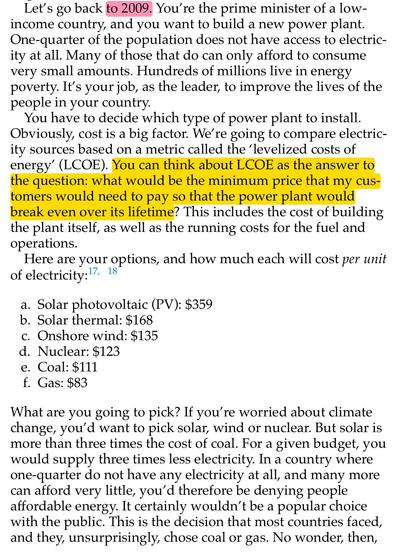#Reading #NotTheEndOfTheWorld: How We Can Be the First Generation to Build a Sustainable Planet by #HannahRitchie
#Auspol #NuclearPower #Climate
Hannah Ritchie is a data scientist who works on climate issues, and lead analyst at Our World in Data website which as lots of stuffs about climate, all in the public domain
tbh i don’t read a lot about climate cos a) most of it is over my head and b) as lily tomlin said, reality is the leading cause of depression amongst those in touch with it
Not the end of the world is a brilliant book on both counts, because it’s written in very accessible language, and provides a healthier perspective on all the big issues.
A related benefit is Ritchie is not a politician, billionaire or spin doctor and, so far as I can tell, can probably be trusted.
——-
IMAGE DESCRIPTIONS - book sample text
Let's go back to 2009. You're the prime minister of a low-income country, and you want to build a new power plant.
One-quarter of the population does not have access to electricity at all. Many of those that do can only afford to consume very small amounts. Hundreds of millions live in energy poverty. It's your job, as the leader, to improve the lives of the people in your country.
You have to decide which type of power plant to install.
Obviously, cost is a big factor. We're going to compare electricity sources based on a metric called the 'levelized costs of energy' (LCOE). You can think about LCOE as the answer to the question: what would be the minimum price that my customers would need to pay so that the power plant would break even over its lifetime? This includes the cost of building the plant itself, as well as the running costs for the fuel and operations.
Here are your options, and how much each will cost per unit of electricity:17, 18
* Solar photovoltaic (PV): $359
* Solar thermal: $168
* Onshore wind: $135
* Nuclear: $123
* Coal: $111
* Gas: $83
IMAGE DESCRIPTION - second text sample
In just 10 years this has changed completely. It's now 2019, and you have to make the same decision. Here are the prices
now:
* Nuclear: $155
* Solar thermal: $141
* Coal: $109
* Gas: $56
* Onshore wind: $41
* Solar photovoltaic: $40
In just a decade, solar photovoltaic and wind energy have gone from the most to the least expensive. The price of electricity from solar has declined by 89%, and the price of onshore wind has declined by 70%. They are now cheaper than coal. Leaders no longer have to make the difficult choice between climate action and providing energy for their people.
The low-carbon choice has suddenly become the economic one. It's staggering how quickly this change has happened.




